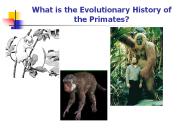Primates PowerPoint PPT Presentations
All Time
Recommended
CHAPTER 6 Section 3 PRIMATES What type of species belong to group Primates? Humans, monkeys, and apes All are mammals What characteristics do all Primates have?
| PowerPoint PPT presentation | free to view
Primates. Chimpanzee. Aye-Aye. Orangutan. Thick-tailed Bush Baby. Common Woolly Monkey. Mandrill Baboon. Potto. Lar Gibbon. Ring Tailed Lemur. Gorilla ...
| PowerPoint PPT presentation | free to view
The Pinnacle of Evolution? Other Hominids? Bigfoot. Sasquatch. Jersey Devil. Abominable Snowman. Other Hominids? Neanderthal. Homo habilis ...
| PowerPoint PPT presentation | free to view
Usually opposable thumbs. Two bones in lower part of limbs and one bone in upper ... SE Asian jungles. Brachiators. Live in small family groups. Little sexual ...
| PowerPoint PPT presentation | free to view
Primate Traits. All primates have: Grasping Hands. Forward Facing eyes (3-D vision) Big Brains ... Primates are Divided into 2 Groups! Prosimians. Anthropoids ...
| PowerPoint PPT presentation | free to view
Gibbon. HUMAN ANCESTRY. Humans and apes have shared ancestry for all but the last few million ... Last common ancestor of gibbons and humans ...
| PowerPoint PPT presentation | free to view
Monkeys and apes have opposable thumbs, meaning they can touch the ventral ... a collision between the Indian and Asian tectonic plates about 10 million years ago. ...
| PowerPoint PPT presentation | free to view
Experience an extensive adventure with the ultimate Uganda primates safari tour. Including gorilla trekking, chimpanzee tracking, and encounters with golden monkeys, this tour offers an immersive and comprehensive primate viewing experience in Uganda's prime habitats.
| PowerPoint PPT presentation | free to download
Mostly live in tropical and subtropical regions in Africa, Asia, and the Americas ... Also known as Gibbons. Smaller, more similar to monkeys. Human History ...
| PowerPoint PPT presentation | free to view
Gibbon. Humans. Lemurs. Hominidae (family) Characteristics of hominids. Bipedal. Rounded jaws ... Walked upright, small stature 3 foot 7 inches and weighed ...
| PowerPoint PPT presentation | free to view
Particularly important in study of artherosclerosis. Adapt well to the laboratory. Have short dense hair coats varying in color from orange to gray; a dark, ...
| PowerPoint PPT presentation | free to view
The Primate Order One of several mammalian orders, such as rodents, carnivores and ungulates. ... suited to insect eating but also fruits and leaves.
| PowerPoint PPT presentation | free to download
A classification system based on similarities and differences. Phenetic Taxonomy = Following Linnaeus, based ... 5. Mammary glands = origin of the term 'Mammal' ...
| PowerPoint PPT presentation | free to download
Squirrel monkeys are found mostly in the tropical lowland rainforests ... Short, bushy tails with long, thick red or white body fur ...
| PowerPoint PPT presentation | free to view
Analysis of Primates Comparisons of Human, Ape, and Australopithecine
| PowerPoint PPT presentation | free to view
... vision for grabbing insects. ... over others, most eat a combo of fruit, leaves, and insects. ... Diet: insects & small vertebrates they catch by leaping ...
| PowerPoint PPT presentation | free to download
New World monkeys: all arboreal, flat spreading noses and prehensile tails ... Gibbon branch split off 15 MYA. Large body size, primarily ground dwellers ...
| PowerPoint PPT presentation | free to view
Tupaidae tree shrew. Tarsier. Lemuridae ... Pesiadapis Paleocene-Eocene North America/Europe. Teihardina early Eocene ... Authralopithecus ...
| PowerPoint PPT presentation | free to view
Chapter 5 Overview of Living Primates
| PowerPoint PPT presentation | free to download
Divisions of Primates. Prosimians ('before ape') Lemurs. Tarsiers. Lorises. Galagos. Lemurs ... African Apes. Chimps. Gorillas. etc... bonobo. Hominids. Homo ...
| PowerPoint PPT presentation | free to download
Having two bones allows for better limb motion and more precise movements ... (an ancestor of living cattle), deer, reindeer and musk ox, to name but a few. ...
| PowerPoint PPT presentation | free to view
Habitat: Dry forests of Madagascar. Locomotion: Walk on all for legs ... Common Chimpanzee. by Veronica Garcia. Name: School: Grade level: Hobbies: ...
| PowerPoint PPT presentation | free to view
Why Study Non-Human Primates? Why Study Non-Human Primates? 1. Behaviors universal among modern primates give us clues to our ancestors behavior 2.
| PowerPoint PPT presentation | free to download
Resiliencia en Primates no Humanos Intergrantes: Alex Olmeda Lizardi Denisse de la Vega Taymee Alvarez Hector de Jesus Alejandro narvaez Que es un Primate?
| PowerPoint PPT presentation | free to download
The Evolution of Primates Chapter 22 * * Figure 22.1: Right hands and feet of selected primates. (Figures not drawn to scale.) (Adapted from A. H. Schultz, The Life ...
| PowerPoint PPT presentation | free to view
Chapter 9 Overview of the Fossil Primates Chapter Outline Introduction Primate Origins Paleocene Primate-like Mammals Eocene Primates Oligocene Primates Miocene ...
| PowerPoint PPT presentation | free to download
Large group of about 200 species ... Galago senegalensis (Bushbaby) Looks of a squirrel. Occasional research use. Loris tardigratus ...
| PowerPoint PPT presentation | free to view
Chapter 6 An Overview of the Primates Chapter Outline Characteristics of Primates Primate Adaptations Primate Classification Survey of the Living Primates Endangered ...
| PowerPoint PPT presentation | free to download
Primate Conservation: Primates on the brink... Some facts... Primates favored (Figure 9.1) ... REASONS. Bushmeat (Africa) Live Primates. Primate parts ...
| PowerPoint PPT presentation | free to view
Overview of Living Primates ... This provides for depth perception, ... Those who study behavior in noncaptive animals are usually trained as physical anthropologists.
| PowerPoint PPT presentation | free to download
... primates include opposable thumbs, binocular vision, and flexible shoulder joint. ... Primates are are divided into two groups prosimians (lemurs), and ...
| PowerPoint PPT presentation | free to view
Langur: Old World Monkey (Vietnam, India, Cambodia) Langur: 'Takeover' Behavior ... Why do Langurs 'Takeover'? Males kill infants to cause mothers to begin ...
| PowerPoint PPT presentation | free to download
Title: Chapter 5 Overview of Living Primates Author: stacy Last modified by: Stacy SCHOOLFIELD Created Date: 11/7/2000 4:49:16 AM Document presentation format
| PowerPoint PPT presentation | free to download
Primates and Human Origins Identify traits that distinguish primates from other mammals. Describe fossil evidence relating humans to primate ancestors.
| PowerPoint PPT presentation | free to view
The western lowland gorilla is among the most numerous with perhaps a population ... The mountain gorilla probably have never been numerous and number about 600 ...
| PowerPoint PPT presentation | free to view
Investigaciones Sobre Resiliencia en Primates Humanos Carla M. Matos Manuel Fuentes Paola M. Castro Sharon D. Estrada Valerie Vargas Psicolog a 3005 Sec.10
| PowerPoint PPT presentation | free to download
Title: Chapter 17 Author: user Last modified by: Tim Heffernan Created Date: 3/10/2006 2:05:47 AM Document presentation format: On-screen Show Company
| PowerPoint PPT presentation | free to download
... closest relatives? bats and rodents. What distinguishes primates from bats, rodents and other ... partial transition from claw to nail. reduced ability to ...
| PowerPoint PPT presentation | free to view
There are about 190 living species of primates in the world. ... Location: San Diego Zoo. Gibbon (Hylobates lar) Primate Senses and the Brain ...
| PowerPoint PPT presentation | free to view
Title: Kottak Subject: Anthropology / Cultural Anthropology Author: Linda Crane Last modified by: Debbie Created Date: 4/19/2001 6:09:34 PM Document presentation format
| PowerPoint PPT presentation | free to download
What is the Evolutionary History of the Primates? 1. EOCENE 54-38 mya. Prosimian Radiations ... branched off from the prosimians much earlier than previously ...
| PowerPoint PPT presentation | free to download
Over time, macroevolutionary forces produce new species from old ones. ... can separate breeding populations and lead to the appearance of new species. ...
| PowerPoint PPT presentation | free to view
primates (Vikki-Hayes, Koko-Patterson, Warshow-Gardners, Lana, Nim Chimsky ... Brubaker, Jed R. 'Wants moar: Visual Media's Use of Text in LOLcats and Silent Film. ...
| PowerPoint PPT presentation | free to download
The Golden Lion Tamarin The Smallest of the Primates By: SS INTRODUCTION name is golden lion Tamarin scientific name leontopithecus rosalia species is the primate ...
| PowerPoint PPT presentation | free to download
They have unpleasant tasting poisonous saliva that they lick onto their fur. Mother lorises also lick the fur of their babies which helps to protect them ...
| PowerPoint PPT presentation | free to view
Innermost digit of at least 1 pair of extremities opposable. Well ... Wild-caught cynomolgus and pig-tail macaques. Philippines (SICONBREC. information) 1994 ...
| PowerPoint PPT presentation | free to view
... of interactions between monkeys separated into acts, ... withdrawn monkey ripped bottle out of wall. Rearing. affects predisposition to EtOH (Grant 2003) ...
| PowerPoint PPT presentation | free to download
... adult male capuchin, one adult female gibbon, one adult male siamang (figure 1) ... White-handed gibbons (Hylobates lar) Orangutans (Pongo pygmaeus) Java macaques ...
| PowerPoint PPT presentation | free to download
Mercury Levels Following Thimerosal Exposure in Infant Nonhuman Primates
| PowerPoint PPT presentation | free to view
DISTRIBUCI N DEL ALIMENTO EN TIEMPO Y ESPACIO. TIPOS DE COMPETICI N POR EL ALIMENTO ... obtienen el alimento antes de que otros tengan la. oportunidad de comer ...
| PowerPoint PPT presentation | free to view
... (AAALAC) independent, non federal organization Decision 1. researchers prepare a proposal 2. reviewed by a committee/ethical team composed of interested parties 3.
| PowerPoint PPT presentation | free to download
With this amount of access, a single hunter harvests approximately 24 woolly monkeys per year. ... ha, therefore containing approximately 282,328 monkeys. ...
| PowerPoint PPT presentation | free to view
Analyse comparative des g nomes de primates: mais o est donc pass e la s lection ... GC / recombination in many taxa (yeast, drosophila, nematode, paramecia, ...
| PowerPoint PPT presentation | free to download
Quote from an eminent HIV vaccine researcher at the AVRS meeting on 12/12/07. Goal: ... We have not tested the T cell vaccine concept yet. ...
| PowerPoint PPT presentation | free to view
Primate to Human From simple to complex! Primates First primates evolved about 50 mya! Two features of the primates: Opposable thumbs: allow for grasping Forward ...
| PowerPoint PPT presentation | free to view
PRIMATE EVOLUTION Chapter 16 Primate Adaptation & Evolution Ch. 16, Sec. 1 Primates Primates = group of animals that includes lemurs, monkeys, apes, and humans Common ...
| PowerPoint PPT presentation | free to download
























































